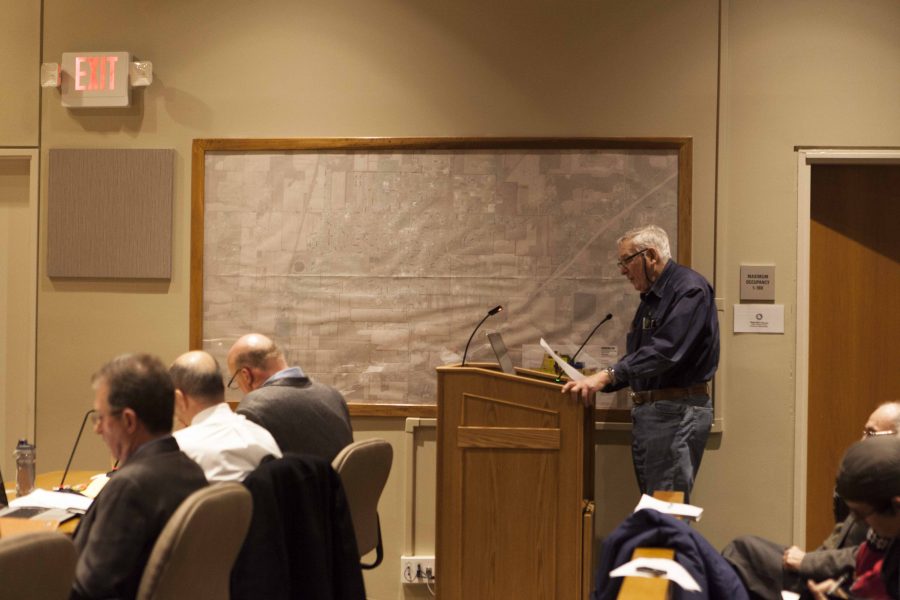Community, Council Mulls Divisive Renewable Energy Credits
Photo by Bryan Rubin, Photo editor
John Elder speaks to City Council at its meeting Monday night concerning the city’s Renewable Energy Credits. The council voted to let citizens return their rebate to the Community Choice Fund.
February 10, 2017
Oberlin residents will now get to decide for themselves how their share of the city’s Renewable Energy Credits should be spent.
Following a divisive resolution made last August to redistribute 85 percent of the $2.6 million the city earned in Renewable Energy Credits to the city’s ratepayers, City Council decided Monday night in a unanimous vote to create the Community Choice Fund, which ratepayers will be able to return all or part of their rebate to.
RECs are certificates that prove a one megawatt-hour of electricity was produced with renewable energy. They can be bought and sold on the open market. Since the 2014 fiscal year, Oberlin has received 80 percent of its electricity from renewable energy and has generated $2.6 million by selling RECs to other cities also in need of renewable energy.
According to Oberlin Finance Director Sal Talarico, ratepayers will have a choice as to whether to keep the money — averaging about $7 to $9 a month saved per homeowner — or return it to the Community Choice Fund. The Community Choice Fund will go towards projects in the city’s Climate Action Plan, such as transportation, green buildings and waste management.
“It’s been difficult because people felt so strongly, and those two opposing viewpoints have been difficult to pull together,” City Councilmember Sharon Soucy said. “But the [Community Choice Fund] is part of that now, and I hope we satisfied both perspectives.”
The other 15 percent of the REC’s money will remain a part of the Sustainable Reserve Program, a fund run by the Oberlin Municipal Light and Power System and the Oberlin Utility Office, which support electricity efficiency and conservation in Oberlin. The Sustainable Reserve Program is largely funded by the sale of RECs.
“Because [RECs in the Sustainable Reserve Program] are received into the electric utility, they are further restricted to be used within the scope of the electric utility,” Talarico said. “So that’s why [they] come with a lot of strings. … We can’t use them for all of the things we want to use them for.” In order to improve communication between city officials and residents and to publicize the Community Choice Fund, City Council also hired a public relations firm called the Impact Group for $77,000 that will come from its 2016 budget. In the packed council chamber, some residents showed up to protest against the public relations firm, along with many who showed up interested in events for Black History Month. During the council meeting, Councilmember Sharon Soucy suggested that the city create a committee including city officials and residents to vet and prioritize the project proposals for the Community Choice Fund. Former Oberlin College Director of Libraries Ray English, however, believes that if the city goes through with the community choice program, it must decide what the money will be used for before they ask people to give money back.
“It’s my view that more money will come into the choice fund if the ratepayers know what their money will be used for,” English said. “I have a lot of experience in donor relations from working with the [Oberlin College] libraries, and I know donors want to know what their gift will be used for, specifically.”
The ordinance now must be approved by the Auditor of State’s Office. The first utility bill to accept Community Choice Fund donations will be in July 2017 and donations will trickle in for the rest of the year. The city will have a better sense about where money will be awarded in 2018, when they know how much money it has to spend.
“I’m excited about the program,” Talarico said. “I would encourage [Oberlin College] students to encourage the administration to participate. It’s going to be a big number for the college, but I would encourage everyone to participate because the benefits will help generations to come. When we benefit the community, it benefits every member, whether it’s the College, the small businesses, the large businesses, the churches, the city government — we’re really in a partnership here.”





















